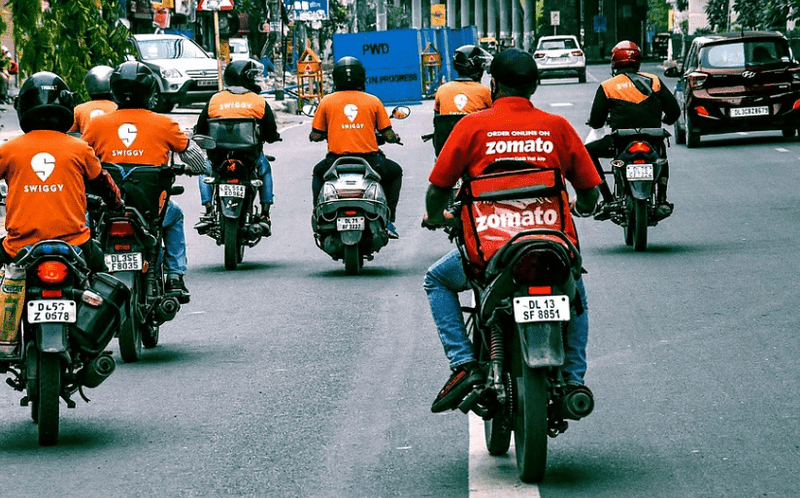
Tech companies are the new empires of today: Alphabet annual revenue surpassed Hungary’s GDP, Facebook employs over 15000 content moderators around the world, and Microsoft has built datavcenters in nearly every corner of our planet. Yet we continue to be sold the myth that the workers of the tech industry, which spans every corner of the globe, have nothing to do with each other.
To hold these tech companies accountable, tech workers in the United States have begun to organize. “Help us be Alphabet’s conscience”, proclaimed the recently-formed Alphabet Workers Union, a minority union composed of full-time employees, temporary employees, vendors, and contractors at Google’s parent company. The gradual normalization of unions in the tech industry has captured a new imagination for what is possible when tech workers organize. However, to truly hold tech companies accountable, workers must not only organize at home, but start to build connections—and eventually organize—with their coworkers abroad.
This essay draws inspiration from emerging tech worker collective actions around the world and explores how tech workers can develop an internationalist labor movement built around collective strength.
Tech is a global industry
To realise the importance of internationalism in the tech labor movement, we must understand the complex and often invisible ways that (predominantly western) tech is enmeshed in the global economy. Today, American tech companies have transnational empires with complex networks of dependencies. Many of them not only have offices abroad, but also rely on swaths of contracted labor in the Global South. Apple is perhaps the most famous example, known for exploiting cheap Chinese labor from manufacturers like Foxconn to produce electronic goods. Large internet firms like Microsoft and Google outsource software development to IT service providers in India, such as Infosys, Cognizant and Wipro. Facebook, similarly, offloads whatever they can’t automate to customer service workers and content moderators, most of whom are based in English-speaking countries in the Global South. These global networks of outsourcing work belie the myth that American tech companies produce enormous value on innovation alone. The reality is much less spectacular: outsourced human labor is at the root of tech’s profit.
The global network of tech capital is much larger than these tech giants themselves. The ride-hail industry is a good example of how the venture capital-backed ecosystem has its tentacles spread throughout the Global South. Japanese venture capital firm Softbank dominates the entire industry with major stakes in Uber, Didi (China), Ola (India), and Grab (South-East Asia). Uber itself owns 28% of Grab and 12% of Didi. This means that the exploitation of drivers in China and South-East Asia (where Grab is the dominant ride-hail service) directly contributes to Uber’s bottomvline. In the struggle against an unaccountable tech elite, tech labor organizers in the US should remember that US tech companies have built their fortunes off the exploitation of workers abroad.
Tech is not unique in this ability to ravage the planet for cheap labor. The globalization of the manufacturing sector laid the groundwork for outsourcing jobs. Capital moved freely while labor was kept within borders. This allowed rich multinational firms to exploit large pools of cheap labor. In some cases, companies take advantage of the lack of labor protections abroad. In other cases, they simply exploit the lower cost of living of the Global South. Either way, outsourcing work to wherever labor is the cheapest allowed multinational firms to drive down wages and undercut any labor protections that workers in the US enjoyed.
The tech sector is unique only in how it accelerated this trend to outsource, and turned it into a seamless process. In manufacturing, outsourcing was common, but not trivial. Countries in the Global South needed capital investment to construct new factories. Infrastructure, such as highways or railroads, was needed for the transportation of goods. In some cases, legal measures needed to be erected to ensure that safe labor conditions were met. In contrast, outsourcing for the tech industry has a much lower barrier. Platforms like Amazon’s Mechanical Turk can directly send work to anyone who has a laptop and an internet connection. Ride-hailing and delivery companies like Uber can onboard drivers around the world so long as the drivers have a car and a smartphone. With software development platforms increasingly standardized and accessible from anywhere in the world, even software engineering work has become easy to send overseas. On top of that, the tech industry has also benefited from outsourcing more traditional roles, such as Tesla’s new gigafactory in China, or in customer service work that is routinely outsourced to low-income English-speaking countries like the Philippines or India.
This tendency to offshore tech work puts the wages of US-based tech workers in direct competition with tech workers abroad. To stay competitive on the global stage, some American tech workers are forced to accept lower wages or risk losing their jobs entirely. After 80 Pittsburg-based Google contractors, employed by the contracting firm HCL, won their union in 2020, the company began to move work to a branch in Poland, discouraging their workers from further engaging in union activity. This tactic used by employers can put a strain on the relationship between domestic and overseas workers. For us to sustainably organize for our own empowerment, we should be asking how we can dismantle a system that pits workers against each other in a race to the bottom, and unite to fight for a higher share of income for all workers. Here, solidarity is not just about extending empathy to overseas workers who have it worse than we do, but strengthening the very foundation of our organizing efforts at home as well.
Opportunities to build transnational solidarity can be difficult to identify because work that is outsourced to the Global South is often rendered invisible. The work of labeling datasets, for example, is veiled by platformization, such that the people assigning these tasks never have to interact with these workers. This makes it virtually impossible for US-based software engineers, whose work relies on labelling services, to develop any connections with their co-workers on the other side of the planet. Another reason that these connections get overlooked is that Silicon Valley companies instill the belief that only Western countries are capable of producing high-value, innovative work, which leads workers to believe that it is natural to outsource “non-innovative” work to the Global South. There are also the practical problems of communicating across countries, such as language barriers and navigating time zones. Part of the work in uniting workers across borders is to overcome these barriers that keep us isolated from each other.
Could hardware engineers at Apple demand better working conditions for Foxconn factory workers? Should machine learning engineers push for more regulation among gig workers who label datasets or moderate content? Can coordinated action from Didi, Grab and Uber drivers apply more pressure to the small handful of owners of the ride-hail industry? These questions can’t be answered without workers on both sides of the border involved in the decision-making process. Indeed, building meaningful and lasting solidarity must start by connecting with our fellow tech workers abroad and giving them a stake in the democratic processes we wish to build at home.
Tech workers’ stake in a “tech Cold War”
US tech companies have a sprawling global footprint and dominate a major share of global internet traffic, but the rise of China’s tech sector has produced another concentration of tech giants with an entirely separate ecosystem.
To begin, we must first understand that the rhetoric of a new tech Cold War is being manufactured at a moment when Chinese tech companies are starting to compete against their US counterparts. TikTok, the popular video-sharing app that shot to fame during the pandemic, is a great case study. Owned by China’s ByteDance, the video-sharing app eclipsed Twitter, Facebook and Instagram in the number of downloads in 2020, making it the first major international social media platform that didn’t come from the US. The Chinese telecom firm Huawei has also been able to break into the international market, which has been otherwise dominated by the US, becoming a major provider of smartphones and telecom infrastructure around the world. These advances have pushed the US government to recoil into a nationalist posture. This played out in the summer of 2020 in a dramatic saga where the Trump administration nearly banned a couple of popular Chinese applications, including TikTok. Even under the Biden administration, we’re continuing to see an intensification of policies that seek to undermine the growth of the Chinese tech sector.
This nationalist blowback from the government has also affected many US companies. Google has been reprimanded by politicians for terminating Project Maven, a military contracted project to develop computer vision technology for drones. Last summer during the tech antitrust hearing, the company was also questioned by the government for opening an artificial intelligence lab in Beijing, which—according to critics—would allow the Chinese military to gain access to cutting-edge technology. Since then, Google has renewed its commitment to support the US military.
Some tech executives—particularly those who have been excluded from the Chinese market—are also parroting the government’s anti-China agenda to argue for minimal regulation and to amass more technocratic power. Mark Zuckerberg has presented the rise of Chinese tech as a threat to American democracy and freedom. Peter Thiel has chastised Google for supposedly sharing artificial intelligence technology with China’s military. Even former Google CEO Eric Schmidt sounded the alarm about the rise of Chinese tech and the need for Silicon Valley to partner with the Pentagon to stay ahead of Chinese competition. Given that the US stock market is held up by the enormous valuations of Big Tech, the rise of Chinese tech threatens America as the global economic leader. This is why US tech elites and politicians—both Democrats and Republicans—are fighting tooth and nail to curb China’s tech industry.
Tech workers need to realise that nationalism is being deployed to obscure the inherent conflict between workers and management. Nationalist protectionism compels workers to put aside their class interests for national interests, making it easier for tech elites to get away with forcing employees to work longer hours and for less pay. We’ve already seen such patterns emerge in China. In response to US sanctions, Huawei founder and CEO Ren Zhengfei said that “[Huawei] must take this opportunity to prevent our employees from slacking off,” justifying their grueling work culture as a matter of national pride. In the US, tech companies also deploy nationalism to justify less oversight from the state or a closer relationship with it. They have opposed antitrust regulations and legitimized lucrative military contracts, all in the name of staying ahead of China.
The future of the tech industry is too important to be left to tech elites and politicians. So far, their leadership has led to the emergence of a “splinternet”—a fracturing of the internet along geopolitical lines—and increased militarization in both countries. The Chinese telecommunications company Huawei has been sanctioned multiple times and placed on the US-entity list, requiring US companies to get government approval before conducting business with them. The US government has also imposed visa restrictions on graduate students from China, particularly those in STEM, supposedly to prevent Chinese students from “stealing” US technology. If we’re not careful, this could lead to even more disastrous—and violent—outcomes such as a push to further develop artificial intelligence capabilities for military applications. The mere description of this relationship as a new tech Cold War indicates the dangerous direction we’re moving in.
Instead, can we look to workers who are similarly exploited in both the US and China to reframe how we think about the battle for tech supremacy in the coming decade? Can building transnational connections among tech workers set us on a path where technology development in these two countries can coexist and flourish?
Towards an international tech labor movement
In recent years, tech workers have made important progress towards more equitable workplaces. Tech workers in the US are unionizing at their workplaces. Delivery workers in Brazil have developed mutual-aid tools to support one another. Call-center workers in the Philippines, who service companies like Facebook, have organized for better working conditions and higher pay. There are countless other stories of tech worker resistance in other countries that are not made privy to a western audience. But despite the tech’s global footprint, most organizing efforts have remained bounded by borders. If we want to organize towards a more just global tech industry, tech workers around the world should start to make these transnational connections and discover the complex, and often nuanced, ways in which their struggles are interwoven.
Luckily, there is precedence of tech workers linking arms across borders. In 2019, just two days before Uber’s IPO, Uber and Lyft drivers from around the world organized a strike for better wages and working conditions. Last year, a global coalition of climate activists, labor organizers, and Amazon warehouse workers organized a global campaign, Make Amazon Pay, to fight for safer warehouse working conditions during the pandemic. Earlier this year, Google’s new union AWU formed an alliance, Alpha Global, with other Google workers around the world. Each of these instances are worth celebrating. However, these actions have been few and far between.
Changing the global tech industry from below requires us to develop lasting and meaningful solidarity, and move beyond flashpoints of unity. Each instance of international solidarity will vary according to circumstance, and we must remember that organizing internationally is slow and hard work that begins with building relationships. Here are a few things we can keep in mind:
- Transnational solidarity is about building relationships across borders. External, third-party organizations can play an important role in instigating and facilitating transnational relationships. But workers on both sides of the border must find ways to have a direct stake on issues at hand. This could mean having a direct line of communication, or even extending base-building practices, such as doing 1:1s, with coworkers abroad. To do this successfully, organizers will have to spend the time and energy to overcome time zones, language barriers and cultural differences in order to truly invest in each other’s struggles. United Electrical, Radio, and Machine Workers of America (UE), who has long been committed to the struggle for internationalism, offers an example of what this can look like. Their rank-and-file members have visited workers and built relationships with unions in Mexico, Canada, Japan, Italy, Brazil, India, and the Philippines.
- Workers should learn about the issues that their coworkers abroad are facing to develop the basis for solidarity. Sometimes the case for solidarity will be clear and have the potential to produce immediate change, such as when Amazon warehouse workers from different countries coordinate actions. Amazon Workers International formed because organizing locally through traditional union methods wasn’t militant enough. Other times, these connections will be less obvious and require deeper analysis, such as mapping out US tech companies’ network of outsourced labor in the Global South, which could even involve analyzing supply chains as a way to understand how struggles in one region relate to another.
- To foster deeper relationships, workers should establish a common identity. In some cases, this identity is as simple as belonging to a single company or a single profession, such as Amazon warehouse workers who check both boxes. Other times, we have to think more flexibly. The way “tech worker,” as an identity, has been conceptualized by the Tech Workers Coalition is a good example. Here, a tech worker not only includes full-time office employees, but also drivers, cafeteria workers, gig workers, warehouse workers, and other office contractors. This flexible identity allowed workers who normally would have no obvious ways to relate to each other, see themselves as co-workers and part of the same community. So far, this has catalyzed several cross-employment types organizing efforts in the industry, such as when Facebook office workers supported their cafeteria workers in their union drive, or when Amazon engineers and designers flew out to picket with striking warehouse workers in Minnesota.
In the global context, the tech worker identity is insufficient. Call center workers or content moderators in the Global South, despite being an integral part of many tech company’s supply chains, are unlikely to see themselves as a tech worker. Organizers can get creative and imagine new ways to form a common identity. One way is to do so around common infrastructure. The anti-996 campaign where Chinese tech workers protested against working 72 hour work weeks is a good example of this. Because the campaign took place on the Microsoft-owned code-sharing platform GitHub, the campaign drew the sympathy of software engineers and other programmers around the world who also rely on GitHub. This led Microsoft employees to create a new GitHub project to show solidarity with the anti-996 campaign. In this case, GitHub became a forum for US and Chinese tech workers, highlighting how globe-spanning platforms can facilitate meaningful connections across borders.
Organizers should take advantage of such platformization and standardization. Delivery workers in China and the US, despite using different platforms, are both subjected to the same logic of algorithmic management. Programmers around the world use the same programming languages and software infrastructure. Platforms like Mechanical Turk means that turkers around the world are having nearly identical working experiences. This offers an unique opportunity for tech workers, across different countries, to develop a shared identity.
International solidarity must be more than just a coordinated action or a multinational campaign. Just like organizing a workplace, building transnational relationships is work and will undoubtedly be hard and slow. In each instance of international solidarity, we must start with a commitment to the struggles of our co-workers abroad, not as a form of allyship or charity, but as a necessity for the co-liberation of tech workers everywhere. Only then, will we have the foundation, community, and solidarity, to transform the global tech industry.
JS Tan is a former tech worker at Microsoft and a graduate student at MIT. He is also a founding member of Collective Action in Tech, a research and media project to advance the tech labor movement.
If you like this essay, click here to read more about the Make Amazon Pay campaign: Workers across Amazon’s supply chain – led by the Progressive International, UNI Global Union, Amazon Workers International, PSI, IndustriALL, the International Trade Union Confederation and many others – are demanding justice from Amazon: for fair wages, its taxes and for its impact on the planet. Join us now.





